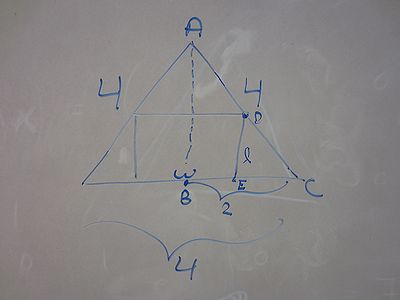Science:Math Exam Resources/Courses/MATH110/April 2013/Question 05/Solution 1
Let's start with drawing a sketch.
The area of the rectangle with width w and length l is given by
- Area = wl
The constrains are 0 ≤ w ≤ 4, 0 ≤ l ≤ h, where h is the height of the surrounding triangle. However, w and l are not independent: a larger width results in a shorter length and vice versa. Hence, the next step is to express the formula for the Area with respect to just one variable. We achieve this by observing the similar triangles ABC and DEC to find
or, equivalently,
Plugging this into the formula for the Area of the rectangle we find
Now, that we expressed the Area as a function of just one variable, we can go about maximizing it as usual: Set the derivative to zero and solve for the variable l:
Setting this expression to zero we obtain l = h/2 as critical point. Since the area vanishes at the endpoints, Area(0) = 0 and Area(h) = 0, the critical point l = h/2 is the maximum we are looking for.
Hence, the dimensions of the rectangle that maximizes the area are





